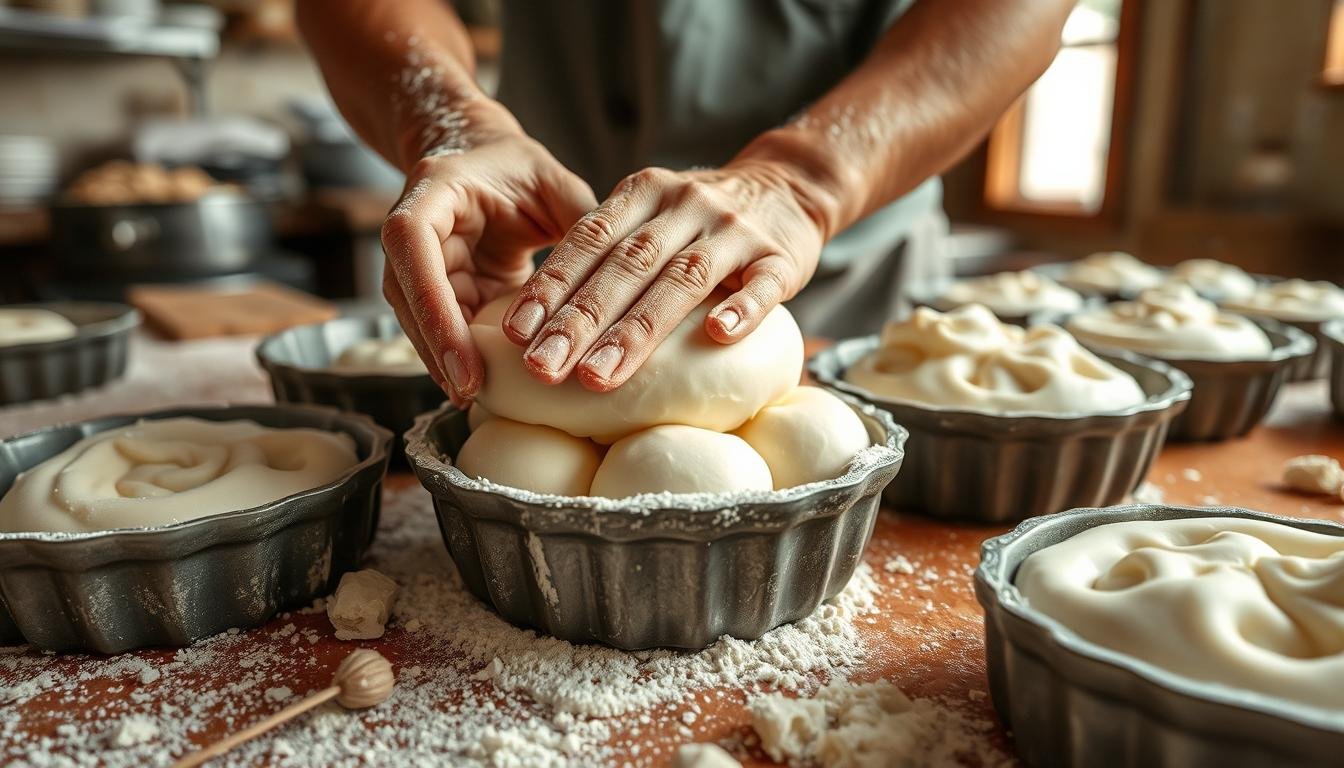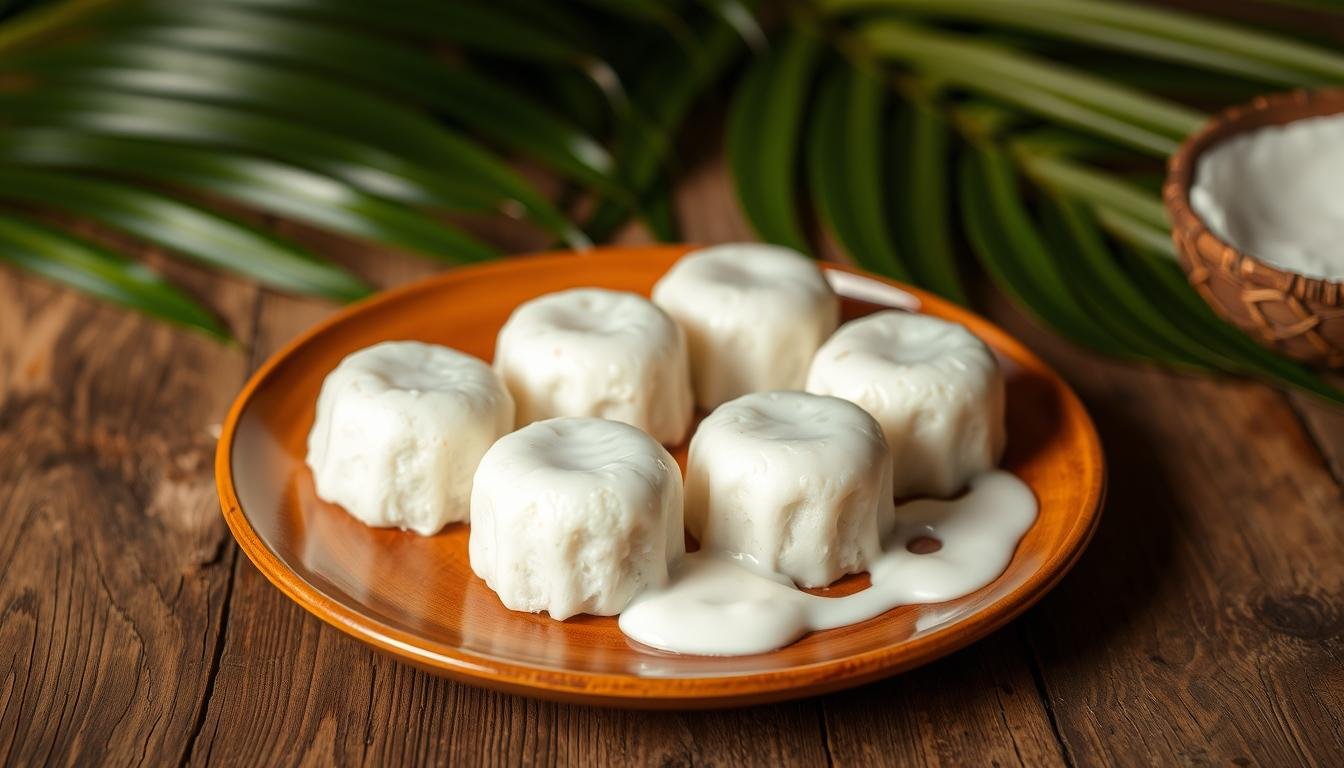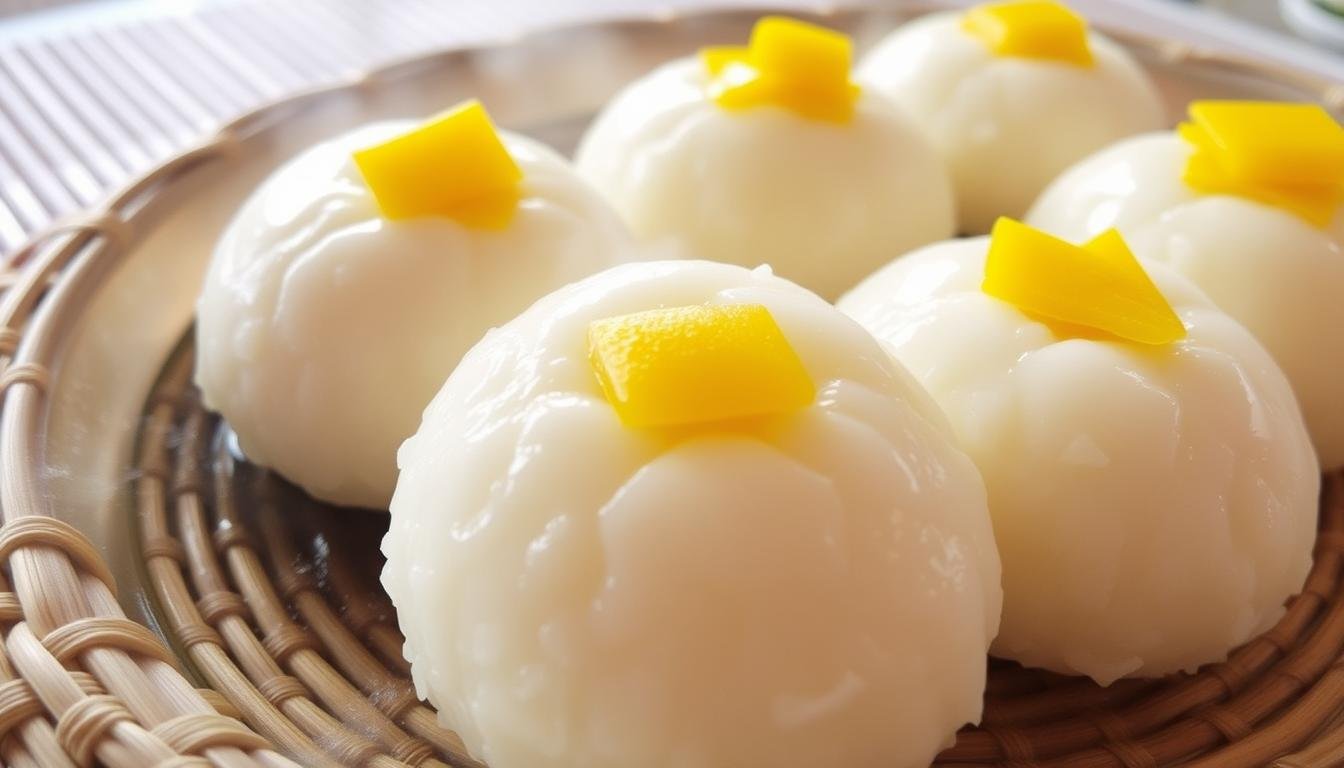Ever wondered why Puto Calasiao, a favorite Filipino rice cake, is so loved? It comes from Pangasinan and is known for its soft, chewy texture and sweet taste. It’s a treat for the senses.
Puto is more than just a snack in Filipino cuisine. It’s a symbol of joy and celebration. Puto Calasiao, however, is a special treat from Pangasinan. It shows the province’s rich culinary traditions.
Key Takeaways
- Puto Calasiao is a beloved Filipino rice cake from the Pangasinan province.
- It is renowned for its soft, chewy texture and subtly sweet flavor.
- Puto, as a broader category, holds cultural significance in Filipino cuisine.
- Puto Calasiao is a true regional delicacy, showcasing Pangasinan’s culinary heritage.
- Puto Calasiao’s unique qualities make it a must-try for lovers of Filipino cuisine.
Ingredients and Preparation
Making the perfect Puto Calasiao, a favorite Filipino steamed rice cake, requires a special mix of ingredients and careful steps. The main parts are glutinous rice flour, coconut milk, sugar, baking powder, and a bit of salt.
Essential Ingredients
- Glutinous rice flour – Gives the Puto its chewy texture.
- Coconut milk – Makes the batter creamy.
- Sugar – Sweetens the rice cake and balances flavors.
- Baking powder – Helps the Puto rise to be light and fluffy.
- Salt – Adds to the overall taste.
Steps
To start making Puto Calasiao, mix glutinous rice flour, coconut milk, sugar, and baking powder until smooth. Then, let the mix ferment for a few hours in a warm place. This step is key for the Puto’s unique taste and light texture.
Once fermented, the batter is filled into molds and steamed until done. This step makes the Puto soft and fluffy. It’s the last step in making this beloved Filipino steamed rice cake.
“The precise combination and preparation of these ingredients are crucial in achieving the authentic taste and texture of this traditional Filipino delicacy.”
The Art of Molding
Puto Calasiao is loved for its taste and the careful molding process. Traditionally, it’s made in bamboo molds or ramekins with banana leaves. This method helps the Puto stay moist-free and perfectly textured.
The art of mold-making is a key part of Puto Calasiao’s tradition. Passed down through generations, it uses natural materials like bamboo and banana leaves. These materials add a rustic charm and improve the Puto’s quality.
Traditional Molding Techniques
Bamboo molds and banana leaves are key to making authentic Puto Calasiao. The process needs attention to detail. Pangasinan artisans have mastered this technique, keeping the Puto true to Filipino kakanin.
Modern Molding Methods
New methods have made Puto Calasiao easier to make. Silicone molds and non-stick pans are now used. They make the Puto fluffy and delicate, meeting today’s tastes.
Both old and new molding methods show the Philippines’ rich culinary heritage. They highlight the skill of artisans and chefs, keeping Puto Calasiao’s essence alive.

Toppings and Flavor Variations
Puto Calasiao is a favorite in Pangasinan. It’s often topped with grated coconut and muscovado sugar. These toppings highlight the region’s rich culinary history.
These toppings add a special touch to the Puto Calasiao. The grated coconut gives a nice texture. The muscovado sugar brings a sweet, caramel flavor.
Classic Toppings
- Grated coconut
- Muscovado sugar
Popular Flavor Variations
Over time, Puto Calasiao has seen creative twists. Some add ube or pandan for color and scent.
These flavored puto calasiao and innovative kakanin meet new tastes. They keep the Puto Calasiao relevant as a Filipino kakanin garnish and regional puto specialty.
Enjoying Puto Calasiao
Puto Calasiao is a beloved steamed rice cake from Pangasinan. It’s often enjoyed as a puto as snack or with other traditional Filipino kakanin serving. A favorite way is with a hot cup of puto calasiao with coffee. This mix of flavors and textures is a delight.
In Pangasinan, Puto Calasiao is a big part of daily life. It’s enjoyed in many ways, showing its importance in Filipino culture.
Puto Calasiao also goes well with other kakanin and Filipino cuisine. It’s great with puto calasiao with dinuguan, a savory stew. The soft putos contrast nicely with the rich dinuguan, making a perfect pair.
It can also be a puto as side dish for various Filipino meals. This shows how versatile Puto Calasiao is in Pangasinan food culture.
Traditional Ways of Serving
Puto Calasiao is served in many ways, showing its cultural significance. It’s often given in small servings for a more enjoyable experience.
Pairing Suggestions with Other Filipino Dishes
Puto Calasiao’s soft and slightly sweet taste makes it great with many Filipino dishes. It goes well with puto calasiao with dinuguan and hearty main courses. It adds to the meal’s flavors and textures.

“The puto market in Calasiao sells various flavors and sizes of puto, with prices starting at thirty pesos for a plastic of puto and nearly a hundred and twenty pesos for a kilo.”
Cultural Significance and Traditions
Puto Calasiao is a beloved rice cake from Pangasinan. It holds deep cultural significance in local celebrations and festivals. These steamed delicacies are woven into the fabric of Filipino traditions.
They often serve as offerings or are enjoyed at festive gatherings. The presence of Puto Calasiao in these events shows its value as a cherished regional specialty. It brings communities together, fostering a sense of shared Pangasinan culinary heritage.
Puto Calasiao’s Role in Local Celebrations and Festivals
Puto Calasiao, the iconic kakanin (traditional Filipino rice cake) of Pangasinan, takes center stage during various local celebrations and festivals. From vibrant puto in traditional festivals to the reverent offerings made during religious ceremonies, these delicate rice cakes are an integral part of the region’s cultural significance.
Their presence in such events reflects the enduring importance of Pangasinan’s culinary traditions within the broader Filipino cultural landscape.
Stories and Legends Associated with Puto Calasiao
Surrounding the beloved Puto Calasiao are various stories and legends that contribute to its cultural significance. These narratives, passed down through generations, often highlight the unique qualities of the rice cakes or their origins in the Pangasinan region.
These puto calasiao folklore and pangasinan puto legends not only add to the mystique of Puto Calasiao but also demonstrate the deep-rooted connection between this traditional dessert and the cultural identity of the Filipino people. These stories serve to preserve and celebrate the enduring legacy of Puto Calasiao as a cherished symbol of Pangasinan’s culinary heritage.
“Puto Calasiao is more than just a delectable rice cake; it is a testament to the rich kakanin in Pangasinan culture and the enduring traditions that shape the culinary identity of the region.”
Conclusion
Puto Calasiao is a beloved Filipino rice cake from Pangasinan. It shows the country’s rich culinary heritage. Its unique ingredients and preparation methods highlight Filipino food traditions.
This traditional kakanin has deep cultural significance. By learning about its history, techniques, and regional variations, you’ll appreciate it more. It plays a big role in Filipino community and identity.
The legacy of Puto Calasiao inspires you to make this filipino rice cake recipe. It connects you to the flavors and traditions of Filipino culture. Making Puto Calasiao lets you enjoy its taste and celebrate its cultural legacy.
Puto Calasiao is a symbol of Filipino culinary traditions. It invites you to explore its flavors and stories. This Pangasinan delicacy is a true treasure of the Philippines.
FAQ
What is Puto Calasiao?
What are the essential ingredients in Puto Calasiao?
How is Puto Calasiao prepared?
What are the traditional molding techniques used for Puto Calasiao?
What are some of the popular toppings and flavor variations for Puto Calasiao?
How is Puto Calasiao traditionally served and enjoyed?
What is the cultural significance of Puto Calasiao in the Pangasinan region and beyond?
Source Links
- Calasiao
- Kakanin: The Uncharted World of Filipino Desserts
- Puto Calasiao Recipe – Today’s Delight
- Puto Calasiao
- Puto Calasiao: The Delightful Rice Cake from Pangasinan — Our Pangasinan
- Cheese Puto Recipe
- Michelle’s Putong Ube – Market Manila
- Puto – Fillipin
- Puto (Steamed Rice Cake) – Jeanelleats Food and Travel Blog
- Your Ultimate Guide to All Kinds of Puto | Booky
- Puto Calasiao: Mini White Balls of Goodness
- Calasiao Puto
- Sweeten your life with a taste of Puto Calasiao
- Region 1 cultures and traditions
- Philippine Culture, Heritage, History, and Language Archives
- Pangasinense People of Pangasinan: History, Culture and Arts, Customs and Traditions [Philippines]
- Lakwatserong Tsinelas: CALASIAO’S DINING TREAT
- CONCLUSION: Thankful to be Filipino
